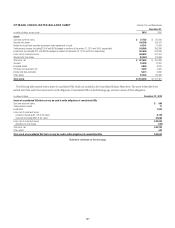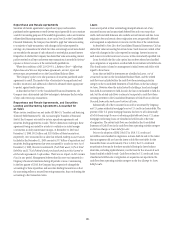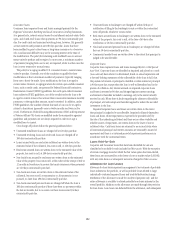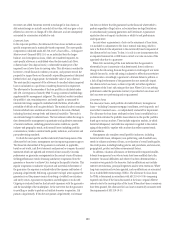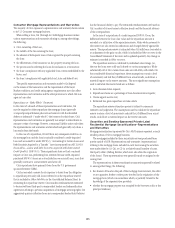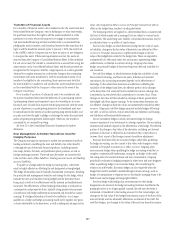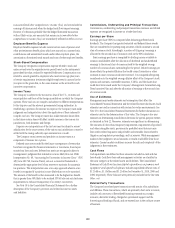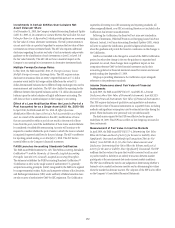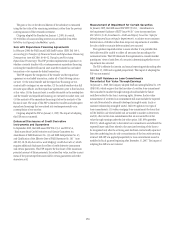Citibank 2010 Annual Report Download - page 167
Download and view the complete annual report
Please find page 167 of the 2010 Citibank annual report below. You can navigate through the pages in the report by either clicking on the pages listed below, or by using the keyword search tool below to find specific information within the annual report.165
Consumer Mortgage Representations and Warranties
The majority of Citi’s exposure to representation and warranty claims relates
to its U.S. Consumer mortgage business.
When selling a loan, Citi (through its CitiMortgage business) makes
various representations and warranties relating to, among other things,
the following:
Citi’s ownership of the loan;•
the validity of the lien securing the loan;•
the absence of delinquent taxes or liens against the property securing •
the loan;
the effectiveness of title insurance on the property securing the loan;•
the process used in selecting the loans for inclusion in a transaction;•
the loan’s compliance with any applicable loan criteria established by the •
buyer; and
the loan’s compliance with applicable local, state and federal laws.•
The specific representations and warranties made by Citi depend
on the nature of the transaction and the requirements of the buyer.
Market conditions and credit rating agency requirements may also affect
representations and warranties and the other provisions to which Citi may
agree in loan sales.
Repurchases or “Make-Whole” Payments
In the event of a breach of these representations and warranties, Citi
may be required to either repurchase the mortgage loans (generally
at unpaid principal balance plus accrued interest) with the identified
defects or indemnify (“make-whole”) the investors for their losses. Citi’s
representations and warranties are generally not subject to stated limits in
amount or time of coverage. However, contractual liability arises only when
the representations and warranties are breached and generally only when a
loss results from the breach.
In the case of a repurchase, Citi will bear any subsequent credit loss on
the mortgage loan and the loan is typically considered a credit-impaired
loan and accounted for under SOP 03-3, “Accounting for Certain Loans and
Debt Securities Acquired in a Transfer” (now incorporated into ASC 310-30,
Receivables—Loans and Debt Securities Acquired with Deteriorated
Credit Quality) (SOP 03-3). These repurchases have not had a material
impact on Citi’s non-performing loan statistics because credit-impaired
purchased SOP 03-3 loans are not included in non-accrual loans, since they
generally continue to accrue interest until write-off.
Citi’s repurchases have primarily been from the U.S. government
sponsored entities (GSEs).
Citi has recorded a reserve for its exposure to losses from the obligation
to repurchase previously sold loans (referred to as the repurchase reserve)
that is included in Other liabilities in the Consolidated Balance Sheet. In
estimating the repurchase reserve, Citi considers reimbursements estimated
to be received from third-party correspondent lenders and indemnification
agreements relating to previous acquisitions of mortgage servicing rights. Citi
aggressively pursues collection from any correspondent lender that it believes
has the financial ability to pay. The estimated reimbursements are based on
Citi’s analysis of its most recent collection trends and the financial solvency
of the correspondents.
In the case of a repurchase of a credit-impaired SOP 03-3 loan, the
difference between the loan’s fair value and the repurchase amount is
recorded as a utilization of the repurchase reserve. Make-whole payments to
the investor are also treated as utilizations and charged directly against the
reserve. The repurchase reserve is estimated when Citi sells loans (recorded as
an adjustment to the gain on sale, which is included in Other revenue in the
Consolidated Statement of Income) and is updated quarterly. Any change in
estimate is recorded in Other revenue.
The repurchase reserve is calculated by individual sales vintage (i.e.,
the year the loans were sold) and is based on various assumptions. While
substantially all of Citi’s current loan sales are with GSEs, with which Citi
has considerable historical experience, these assumptions contain a level
of uncertainty and risk that, if different from actual results, could have a
material impact on the reserve amounts. The most significant assumptions
used to calculate the reserve levels are as follows:
Loan documentation requests;•
Repurchase claims as a percentage of loan documentation requests;•
Claims appeal success rate;•
Estimated loss given repurchase or make-whole.•
The repurchase reserve estimation process is subject to numerous
estimates and judgments. The assumptions used to calculate the repurchase
reserve contain a level of uncertainty and risk that, if different from actual
results, could have a material impact on the reserve amounts.
Securities and Banking
-Sponsored Private Label
Residential Mortgage Securitizations—Representations
and Warranties
Mortgage securitizations sponsored by Citi’s S&B business represent a much
smaller portion of Citi’s mortgage business.
The mortgages included in these securitizations were purchased from
parties outside of S&B. Representations and warranties (representations)
relating to the mortgage loans included in each trust issuing the securities
were made either by (1) Citi, or (2) in a relatively small number of cases,
third-party sellers (Selling Entities, which were also often the originators
of the loans). These representations were generally made or assigned to the
issuing trust.
The representations in these securitization transactions generally related
to, among other things, the following:
the absence of fraud on the part of the mortgage loan borrower, the seller •
or any appraiser, broker or other party involved in the origination of the
mortgage loan (which was sometimes wholly or partially limited to the
knowledge of the representation provider);
whether the mortgage property was occupied by the borrower as his or her •
principal residence;




